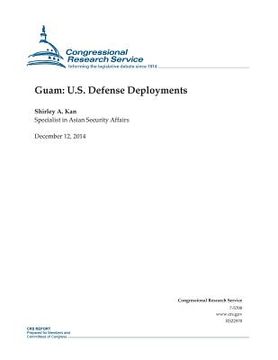Guam: U.S. Defense Deployments
Synopsis "Guam: U.S. Defense Deployments"
Since 2000, the U.S. military has been building up forward-deployed forces on the westernmost U.S. territory of Guam (west of Hawaii) to increase U.S. operational presence, deterrence, and power projection for potential responses to crises, disasters, or other contingencies to support Japan, Republic of Korea (ROK), the Philippines, Taiwan, or others in Asia. Since 2006, Valiant Shield exercises based at Guam have boosted U.S. military readiness for joint operations in the Pacific. The defense buildup on Guam has been moderate. China has concerns, suspecting Guam's buildup to be directed against China. There has been concern that China and North Korea could target Guam with missiles. China's People's Liberation Army (PLA) Navy has increased activities in waters around Guam. Still, Guam's role expanded in engaging with the PLA. In 2006, the United States and Japan had agreed on a Realignment Roadmap to strengthen their alliance, including a buildup on Guam to cost $10.3 billion, with Japan contributing 60%. Goals were to start the related construction on Guam by 2010 and to complete relocation of about 8,000 marines from Okinawa to Guam by 2014. In Tokyo on February 17, 2009, the Secretary of State signed a U.S.-Japan agreement on the relocation of the III Marine Expeditionary Force personnel from Okinawa to Guam that reaffirmed the "Roadmap" of May 1, 2006. However, the Marines' relocation will not occur by 2014 and will be more geographically distributed. Opposition on Okinawa to the U.S.-Japan plan for a Futenma Replacement Facility (FRF) to replace the Marine Corps Air Station Futenma brought implications for the Marines' move from Okinawa to Guam. Despite the dispute over the FRF, Japan has budgeted for its contributions to the Marines' move. By 2011, some Members urged attention to concerns that included Japan's impasse, expanded costs, and the delay in the realignment even as a strong U.S. military presence and readiness remain critical in the Asia-Pacific. On May 11, 2011, Senators Carl Levin, John McCain, and Jim Webb called for a review of plans to restructure military forces in Japan, ROK, and Guam, in order to make progress. President Obama issued in January 2012 the defense guidance for the strategy of "rebalancing" diplomatic, defense, and economic priorities more to the Asia-Pacific. This "rebalance" further raised Guam's profile as a "strategic hub." China has tried to raise doubts about the U.S. rebalance. In February 2012, the United States and Japan agreed to adjust the Roadmap and separate the move of marines from the plan for the FRF, in order to make progress separately. A U.S.-Japan Joint Statement of 2012 specified that out of about 9,000 marines to be relocated from Okinawa, about 5,000 marines would move to Guam. Out of the new estimated cost of $8.6 billion, Japan would contribute $3.1 billion. A Joint Statement of 2013 pointed to a later relocation of marines to Guam that will start in the first half of the 2020s. In April 2014, President Obama issued a U.S.-Japan Joint Statement, reaffirming that "the United States and Japan are also making sustained progress towards realizing a geographically distributed, operationally resilient, and politically sustainable U.S. force posture in the Asia Pacific, including the development of Guam as a strategic hub." Preparation includes a draft environmental study (April 2014), a final study (2015), and a Master Plan for Guam (July 2014). The Master Plan estimated total costs of $8.7 billion.

